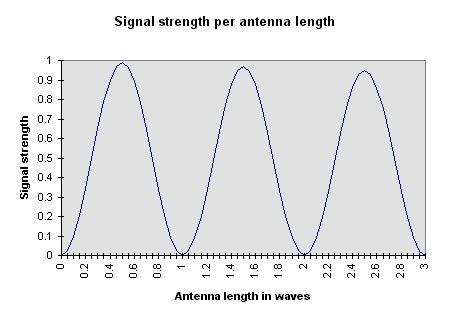|
|||
Short answer: There's an ideal length for the antenna. Long answer: The ideal length of an antenna is half a wavelength of whatever the frequency is that it's designed to operate with. 800 MHz cellular has a wavelength of approximately 37 centimeters, about 15 inches. So an ideal antenna would be half that, about seven and a half inches. This refers to the dipole, the distance from the tip of the antenna to the opposite end of the antenna buried inside the phone somewhere (usually near the bottom). 1900 MHz PCS has a wavelength of approximately 16 centimeters, about six inches. So the ideal antenna dipole is about 3 inches. The ideal antenna performs best if it is exactly perpendicular to the impinging waveform. In practice the orientation of the phone is somewhat random; the antenna will be pointed approximately upward, but probably at a slant. So cell phone manufacturers generally try to make the antenna 5/8's of a waveform, because if the antenna is at a slant, its cross-section relative to the impinging waveform will be near to the ideal half a wavelength. For a dual-band phone, one which operates at both 1900 and at 800 MHz, it's obvious that determining the antenna length is a bit of a problem. (But not insoluble; it's just a compromise. Since digital is usually more resilient than AMPS, usually the length is optimized for 800 MHz.) Making the antenna shorter will both decrease the amount of incoming signal the phone receives, and will make the phone's transmitter less efficient. But CDMA operates over a very wide range of effective powers, and it can usually compensate. That's why the phone will usually work with the antenna down. And because it's digital, if it is working it will sound exactly the same. This has lead some people to conclude that the antenna is not actually doing anything for them, which is not quite correct. While the phone can operate with the antenna down, it's easier on the phone if you raise the antenna; it has more signal ceiling to work with and will be less likely to drop the call. Also, it will use somewhat less transmit power, and your battery will last somewhat longer. Making it longer with some sort of extension is worse than useless; it actually degrades the signal. If the antenna is exactly one wavelength long and is exactly perpendicular to the impinging waveform, it will pick up essentially no signal at all. When it reaches one and a half wavelengths, signal strength is again maximized, but for physical reasons it's a bit lower than the strength with a half-wavelength antenna. (The physical reason is that the antenna is not an ideal conductor.) Here's a chart which shows this relationship between signal strength and antenna length in wavelengths (this is an approximation):
|
|||

